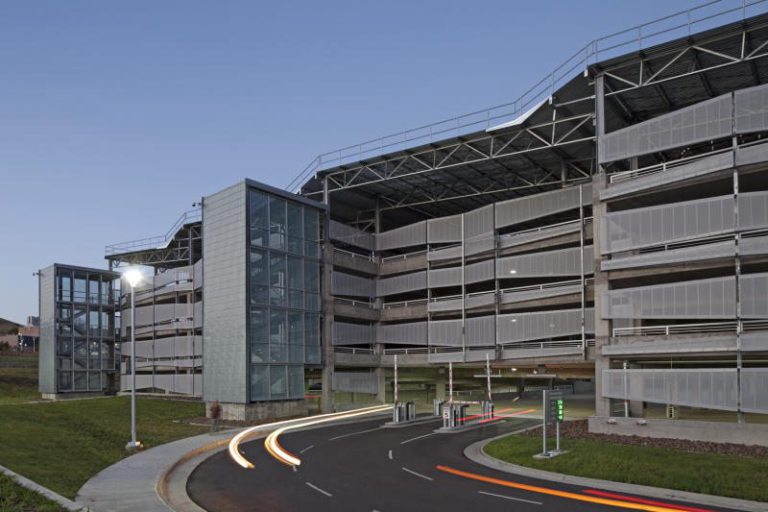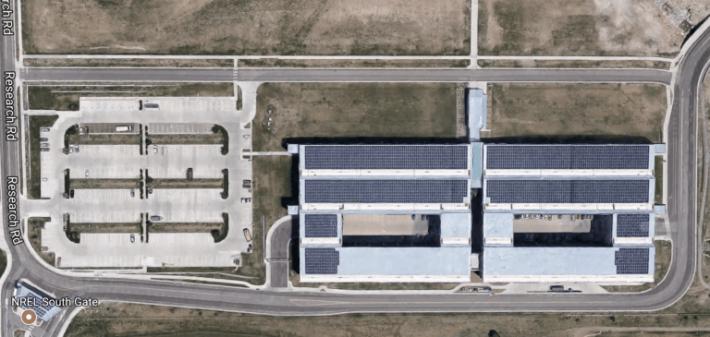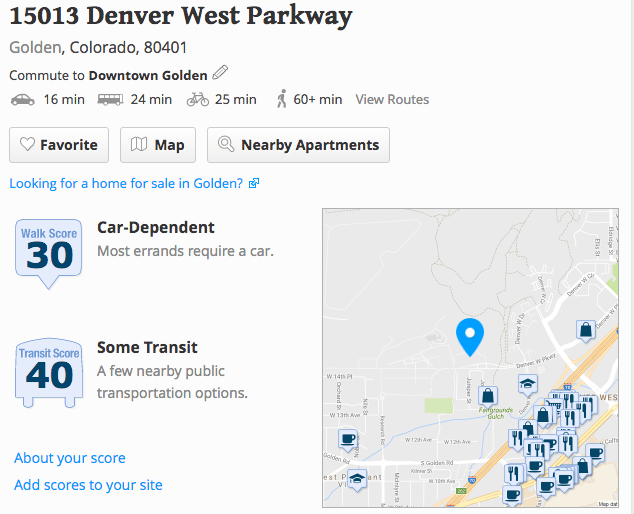How Green Is My Free Parking Structure? Not Very.
12:58 PM EDT on July 20, 2017

Net zero, provided you ignore what its used for. Photo: Haselden Construction
Cross-posted from City Observatory.
The researchers at the National Renewable Energy Lab are hard at work on a lot of cool ideas for reducing pollution and promoting greater energy efficiency. They’re figuring out ways to improve photovoltaics and increase the efficiency of wind energy generation, and are a research leader in integrating these renewable energy sources into utility scale energy systems. The staff are also developing biofuels that could one day replace fossil fuels in transportation and other uses. They have an entire program dedicated to transportation:
NREL research, development, and deployment (RD&D) accelerates widespread adoption of high-performance, low-emission, energy-saving strategies for passenger and freight transportation. Dedicated to renewable energy and energy efficiency, NREL and its industry, government, and academic partners use a whole-systems approach to create innovative components, fuels, and infrastructure for electric, hybrid, fuel cell, and conventional vehicles.
When the scientists working on tough problems of how to maximize the use of renewables and minimize energy use and pollution are charged with building the place they work, you can bet they’ll put a lot of thought into how to make things as smart and efficient as possible. It’s festooned with arrays of photovoltaic cells to generate electricity on site. Because it’s one of the lab’s newest structures, they’ve extensively modeled the daylighting of the building to minimize lighting requirements, and made extensive use of recycled (and re-cyclable aluminum). The building’s lights are mostly on only at night, and only when motion detectors recognize occupants. This new $31.5 million building is shooting to be LEED Platinum and even be a “net zero” energy structure.
But there’s one big environmental (and energy) problem with this shiny new structure: It’s an 1,800 space parking garage. Not only that, but (if you’re Don Shoup, please don’t read this) they don’t charge employees anything to use the garage. The whole thing strikes us as utterly tone deaf and a flat contradiction to the organization’s mission statement. So, in addition to the lab being located in a suburban office park on the fringe of the Denver metro area, its employees are strongly incentivized–nay, subsidized–to drive their private cars to work. And that’s exactly what an overwhelming majority of them do.
A giant, free garage encourages energy consumption and pollution
We contacted the Lab to learn more about commute patterns and parking policies. They shared with use the mode split from their latest (2014) commuting survey. Not surprisingly, about two-thirds of all workers drive alone to work daily, almost ten times the share that either carpool or vanpool.
Drive alone – 65%
Walk – 0%
Bicycle – 4%
Carpool – 5%
Vanpool – 2%
Transit – 14%
Motorcycle/Scooter – 1%
Telework – 9%*
These figures represent typical commute patterns. As many as a quarter of lab employees telework at least some days, and the lab estimates that telework offsets about 9 percent of commute trips.
We asked about parking prices for commuters. Lissa Myers, who is the Lab’s Sustainable Transportation & Climate Change Resiliency Practice Leader told us:
Parking is free on our campus and we have an abundance of it.
That’s the problem, really. We have an abundance of proven technologies that are “high-performance, low-emission, energy-saving strategies”–they include dense cities, cycling, transit, walking and car pooling. But technologies don’t work, or don’t work well if we subsidize people to use energy-wasting alternatives and locate large concentrations of workers in places where they have few alternatives but to drive single-occupancy vehicles.
Location, location, location
And because the lab is located on the urban fringe, rather than in a central, transit served location (like say, downtown Denver) its employees have few nearby housing options that would let them bike, walk or take transit to work. The lab has a Walk Score of 30 (out of a possible 100) making it “car dependent”–the nearest coffee shops, restaurants and grocery stores are more than a half mile away, and generally on the other side of the I-70 freeway, meaning that if they leave the lab for errands or a meal, its most likely they’ll drive.
Promoting renewable energy is (and energy conservation and greenhouse gas reductions) is a matter of both technology and incentives. An agency that’s supposedly dedicated to these tasks ought to do a better job of aligning its policies with its mission. There’s little hope that people will use a non-polluting bicycle or take transit to work, for example, if they have free use of parking.
Excess capacity
We also have to note the capacity of the NREL garage, relative to the size of the institution is enormous. The garage, completed in 2012, contains 1,800 spaces, while the lab has just 1,500 employees. So that’s about 300 spaces more than are needed to provide one space per employee. Based on the lab’s mode split, only slight more than 1,000 spaces are occupied per day (about 975 by single occupancy commuters, about 30 more by carpools (if we assume 2.5 workers per carpool), and about 6 spaces for van pools (assuming six workers per van pool) and the equivalent of 8 spaces by motorcycles and scooters (assuming 2 two-wheelers per parking space). That means the garage has almost 75 percent more capacity (1,800 spaces supplied for about 1,025 vehicles) than is needed to house NREL’s worker’s vehicles–and that a price of zero to the users. (To be sure, the garage also accommodates visitors, but that doesn’t materially affect our analysis. According to the NREL’s economic impact statement, the lab gets about 25,000 visitors per year, which works out to about 100 visitors per day; if they each needed a parking space for an entire day, that would work out to about 100 parking spaces. In reality, typical demand would be less because most visitors stay less than an entire day and many arrive in multi-occupancy vehicles or via transit or hired vehicles).
Having built the garage, their are powerful bureaucratic incentives to see it as full as possible; that, and employee resistance to having to pay for something that they’ve been given for free, means this problem is likely to persist. It’s hard to say what’s worse: an over-sized garage that’s mostly empty (representing a waste of resources that could be better used for other things, like say research on clean energy) or a garage that’s nearly full of single-occupancy vehicles (because its free to users). As we’ve suggested, and as our colleague Tony Jordan reminds us, dedicated parking garages are likely to become big stranded assets with the advent of autonomous vehicles. But it looks like that’s not something that’s on NREL’s mind. The agency’s construction manager Tony Thornton tells the American Galvanizer’s Association NREL wanted a building that would last for a 100 years. Whatever they’re planning for renewable energy, it doesn’t look like they expect it to influence car ownership or driving patterns, if they expect their parking garage to be around through 2100.

The claim that a parking garage can be “zero net energy” requires casting a blind eye to the structure’s central purpose. It’s only zero net energy if you completely ignore the energy used by the cars it’s designed to store, and that you ignore how building garages and subsidizing their use prompts more driving, more energy consumption and more pollution.
Read More:
Stay in touch
Sign up for our free newsletter
More from Streetsblog USA
Talking Headways Podcast: Money is a Lot of Different Things
It's Part II of our discussion with Jim Kumon!
If Thursday’s Headlines Build It, They Will Come
Why can the U.S. quickly rebuild a bridge for cars, but not do the same for transit? It comes down to political will and a reliance on consultants.
Wider Highways Don’t Solve Congestion. So Why Are We Still Knocking Down Homes for Them?
Highway expansion projects certainly qualify as projects for public use. But do they deliver a public benefit that justifies taking private property?
Kiss Wednesday’s Headlines on the Bus
Bus-only lanes result in faster service that saves transit agencies money and helps riders get to work faster.
Freeway Drivers Keep Slamming into Bridge Railing in L.A.’s Griffith Park
Drivers keep smashing the Riverside Drive Bridge railing - plus a few other Griffith Park bike/walk updates.





